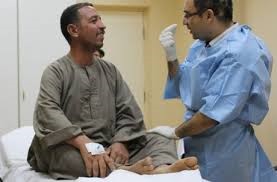
The World Health Organization has declared hepatitis C a global health problem, with approximately 3% of the world’s population (roughly 170-200 million people) infected with HCV. In the US, approximately 3 million people are chronically infected, many of whom are still undiagnosed. In Egypt the situation is quite worse. Egypt has a population of 62 million and contains the highest prevalence of hepatitis C in the world. The national prevalence rate of HCV antibody positivity has been estimated to be between 10-13% (Mohamed MK. Epidemiology of HCV in Egypt 2004. The Afro-Arab Liver Journal, 2004, vol 3, No2, (July), pp 41-52). Since 30-40% of individuals clear the infection shortly after exposure based on national studies and village studies in Egypt, the estimated adjusted national prevalence rate of chronic hepatitis C infection is 7.8% or 5.3 million people in 2004 (American Journal of Gastroenterology 2006). Only one third of these individuals (1.75 million) are estimated to have chronic liver disease (elevated ALT) and, furthermore, among these one third (577,000 people) are suffering from advanced liver disease.
Interestingly, genotype 4 represents over 90% of cases in Egypt. Chronic HCV is the main cause of liver cirrhosis and liver cancer in Egypt and, indeed, one of the top five leading causes of death. In Egypt, the major route of exposure appears to be due to injection therapy and inadequate infection control practices. In addition to blood transfusions prior to 1994, the major risk factor associated with HCV infection is a history of antischistosomal injection treatment before 1986. Schistosomiasis used to be a common parasitic disease in Egypt acquired through swimming or wading in contaminated irrigation channels or standing water. Thus, farmers and rural populations were at greatest risk, and this is supported by the higher prevalence rate of HCV in the Nile delta and rural areas. Schistosomiasis can lead to urinary tract or liver damage over many years. Prior to 1986 the mainstay of treatment was intravenous tartar emetic. Widespread treatment campaigns were carried out in the countryside of Egypt in the 60’s-70’s and early 80’s. At the time of availability of only glass syringes, needles were routinely inadequately sterilized by boiling due to time restraints and limited resources. Overall, despite improvement in schistosomiasis-related morbidity between 1980-1990, these treatment campaigns set the stage for the current large hepatitis disease burden in Egypt. Further, with such a high background prevalence rate, transmission of hepatitis C through other non medical routes has become more significant. For example, tattooing, circumcision or other medical procedures performed by non-medical personnel are more frequent routes of infection in Egypt than elsewhere. In addition, household transmission, vertical transmission and sexual transmission are routes that are also under investigation.
As expected, the availability and cost of treatment for hepatitis C in Egypt is quite prohibitive. Although the most common methods of previous hepatitis C transmission (injection-based treatment for schistosomiasis and blood transfusions) have been addressed, the prevalence in those under age 20 is still approximately 5-8%, demonstrating the continued presence of significant hepatitis C transmission in modern-day Egypt (Mohamed MK. Epidemiology of HCV in Egypt 2004. The Afro-Arab Liver Journal, 2004, vol 3, No2, (July), pp 41-52). Egypt is in need of additional training, funding and research in order to combat the hepatitis C epidemic.
Sustainable Sciences Institute (SSI) is a non-profit organization founded by Dr. Wakil and colleagues to assist researchers in developing countries with skills and resources so they can better address local public health needs. SSI has established a program focusing on hepatitis C in Egypt. We have been working together with Egyptian colleagues to establish consensus regarding the current hepatitis C situation and a research agenda for the future. Providing journals, textbooks, and up-to-date information on hepatitis C and research techniques is also a priority. These efforts of collaboration with local experts and the enhancement of training and funding will, hopefully, make a difference in Egypt’s struggle to address the hepatitis C burden.

Leave A Comment